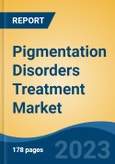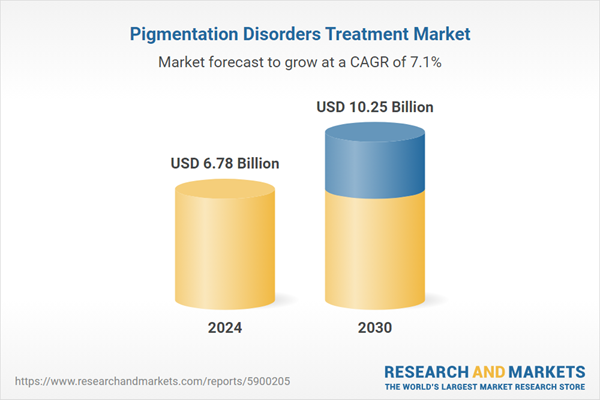Speak directly to the analyst to clarify any post sales queries you may have.
10% Free customizationThis report comes with 10% free customization, enabling you to add data that meets your specific business needs.
Key Market Drivers
Technological Advancements
Rapid advancements in technology have greatly enhanced the effectiveness and precision of pigmentation disorder treatments. Innovations in laser-based therapies, including Q-switched, fractional, and picosecond lasers, have enabled targeted treatment of pigmented lesions with minimal risk of scarring. The adoption of Intense Pulsed Light (IPL) systems has broadened treatment accessibility for conditions such as age spots and sun-induced pigmentation. In addition, fractional radiofrequency (RF) devices that integrate microneedling with RF energy offer effective non-invasive treatment with minimal downtime.The refinement of topical formulations through nanotechnology and enhanced transdermal delivery systems has increased the potency and bioavailability of active ingredients. Cryotherapy tools with improved temperature control, along with the emergence of picosecond lasers capable of ultra-short pulse durations, have expanded therapeutic options, especially for resistant pigmentation conditions. These technological strides have collectively improved clinical outcomes and patient satisfaction across diverse skin types and indications.
Key Market Challenges
Cost of Treatment
The high cost of pigmentation treatment poses a significant challenge for broader market accessibility. Procedures such as laser therapy and combination treatment plans can be expensive, especially when multiple sessions are required for optimal results. Out-of-pocket expenses can be substantial, particularly in regions where pigmentation therapy is classified as elective and not covered by insurance. Beyond procedural fees, patients also bear the costs of consultation, follow-ups, prescription creams, and maintenance therapies. Premium skincare products designed for pigmentation disorders can be financially burdensome, and specialized treatments often involve travel to advanced dermatology centers, further escalating costs. The long-term nature of treatment, requiring consistent care and follow-up, adds to the financial strain, thereby limiting treatment adoption among cost-sensitive populations.Key Market Trends
Personalized Medicine
The shift toward personalized medicine is transforming the treatment of pigmentation disorders. Tailored therapeutic strategies are now being developed based on individual patient factors such as genetic profile, skin type, lifestyle, and prior treatment responses. Genetic insights have enabled identification of mutations and variations linked to pigmentation irregularities, helping clinicians develop targeted therapies.Pharmacogenomic testing further refines this approach by determining the most effective drug or topical agent based on an individual’s genetic makeup. Skin type-specific therapies and the integration of multimodal treatments - such as combining chemical peels with laser resurfacing - are gaining traction. Moreover, advancements in laser technology now permit customization of wavelength and energy settings based on patient-specific needs. Empowering patients with information and involving them in treatment decisions is also a key feature of this trend, contributing to improved adherence and satisfaction.
Key Players Profiled in this Pigmentation Disorders Treatment Market Report
- Zerigo Health
- Bausch Health Companies Inc.
- Glenmark Pharmaceuticals Limited
- Novartis AG
- Pfizer Inc.
- Teva Pharmaceutical Industries Ltd
- Bayer AG
- CLINUVEL PHARMACEUTICALS LTD
- Strides Pharma Science Limited
- Astellas Pharma Inc.
Report Scope:
In this report, the Global Pigmentation Disorders Treatment Market has been segmented into the following categories, in addition to the industry trends which have also been detailed below:Pigmentation Disorders Treatment Market, by Indication:
- Hyperpigmentation
- Hypopigmentation
Pigmentation Disorders Treatment Market, by Treatment & Therapies:
- Chemical Peels
- Dermabrasion
- Laser Resurfacing
- Melasma
Pigmentation Disorders Treatment Market, by End User:
- Dermatology Clinics
- Hospitals
Pigmentation Disorders Treatment Market, by Region:
- North America
- United States
- Canada
- Mexico
- Asia-Pacific
- China
- India
- South Korea
- Australia
- Japan
- Europe
- Germany
- France
- United Kingdom
- Spain
- Italy
- South America
- Brazil
- Argentina
- Colombia
- Middle East & Africa
- South Africa
- Saudi Arabia
- UAE
Competitive Landscape
Company Profiles: Detailed analysis of the major companies present in the Global Pigmentation Disorders Treatment Market.Available Customizations:
With the given market data, the publisher offers customizations according to a company's specific needs. The following customization options are available for the report.Company Information
- Detailed analysis and profiling of additional market players (up to five).
This product will be delivered within 1-3 business days.
Table of Contents
Companies Mentioned
The leading companies profiled in this Pigmentation Disorders Treatment market report include:- Zerigo Health.
- Bausch Health Companies Inc.
- Glenmark Pharmaceuticals Limited
- Novartis AG
- Pfizer Inc.
- Teva Pharmaceutical Industries Ltd
- Bayer AG
- CLINUVEL PHARMACEUTICALS LTD
- Strides Pharma Science Limited
- Astellas Pharma Inc.
Table Information
| Report Attribute | Details |
|---|---|
| No. of Pages | 178 |
| Published | May 2025 |
| Forecast Period | 2024 - 2030 |
| Estimated Market Value ( USD | $ 6.78 Billion |
| Forecasted Market Value ( USD | $ 10.25 Billion |
| Compound Annual Growth Rate | 7.1% |
| Regions Covered | Global |
| No. of Companies Mentioned | 11 |









